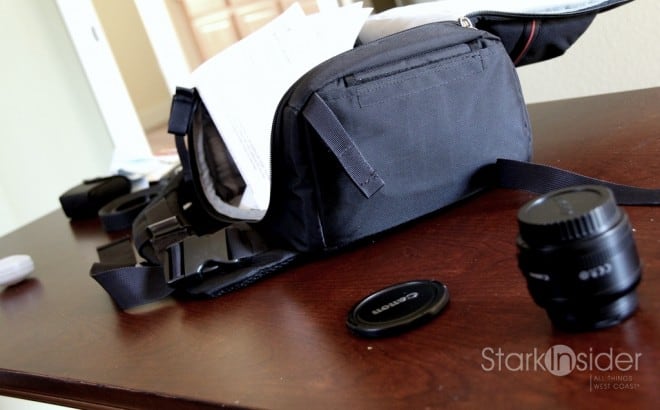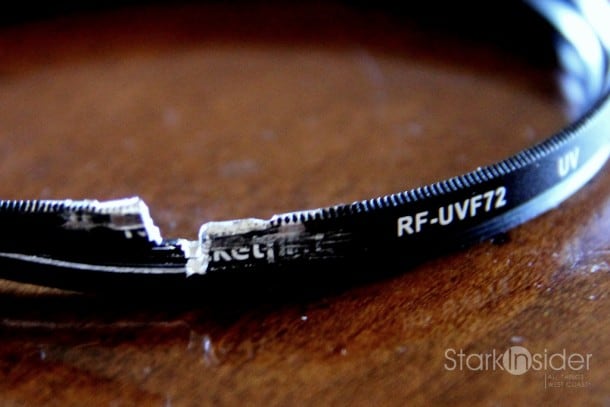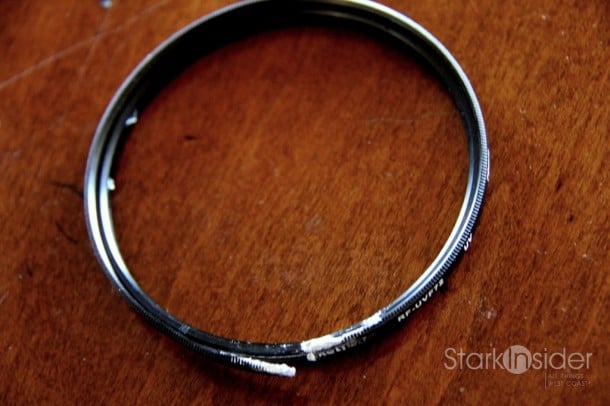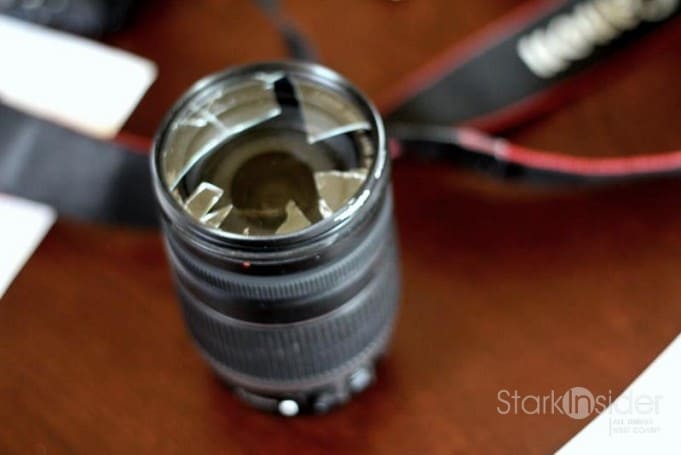If you’ve dropped your DSLR, here’s one way to remove a bent filter ring.
It finally happened. It was only a matter of time. But when it happened, I did not expect it to happen.
Fortunately it was only hardwood flooring, when my Canon EOS 60D took a four foot dive off the office desk and onto the floor, resulting in that most cringe-inducing-opposite-of-joy sound: the shattering of glass.
Shards of glass sprayed across the floor, and in that instant I thought I had died. Okay, over-reaction? Probably. But legitimate concern for my $1,500 investment… ah, well, I’ll let you take a guess on that one!
When the split-second of drama had passed, I took a deep breath and began to take stock of the situation. How bad was it?

On the down side the lens hood was inverted and in storage position at the time of the fall, meaning it could do nothing to absorb the impact. But–good news! … and it’s all relative at this point–the lens filter had, at least visibly, taken the brunt of the damage, and was shattered as you see in this photo.
I picked up the camera, and shook loose fragments onto the floor. From there, I used a blower to carefully remove tiny bits of glass from the lens, which appeared unharmed, at least on the exterior.
I then tried to remove the now destroyed filter by twisting the ring. No dice. Regardless of how much (careful) force I applied, the ring would not budge. Upon further inspection I could see the point of impact was along the ring. Now bent, it would not twist off.
What to do?
I suspected my next step would be to head to a local camera repair shop, el pronto. I was under the wire as we had a shoot and interview at Teatro ZinZanni that very evening.
So I Googled- surely I was not alone in this predicament. Sure enough there were scores of others who had dropped their camera, bent their ring, and lived to tell.
There are a variety of suggestions on how to remove a bent filter ring. Many I’m sure would work. The one I chose was the HACKSAW METHOD. Scary stuff, and just in time for Halloween no less. It sounds far worse than it is, and, in my case, solved the problem and returned the 60D to beautiful working order just in time for our dinner theater shoot.
Here’s what I did.
Please note: I make no guarantees here that this (a) will work for you, or (b) won’t potentially do further damage to the lens. If you’re careful, move slowly (take your time!), I suspect you will have success- but again, proceed at your own risk.
HOW TO REMOVE A BENT FILTER RING
1. Remove the lens from the body – fortunately my EOS 60D body appeared unscathed after the fall.
2. Protect the Lens – With the filter smashed, the lens is exposed greatly increasing the risk it will get scratched. I used a small foam insert that came with one of the 72mm filters that I had purchased. I was able to gently position this inside the filter itself, completely protecting the glass.
3. Carefully remove shards of glass (optional) – I’m not sure this is necessary, but I decided to pluck the remaining shards. They came out easily and once removed provided more space for the next steps.
4. Use a hacksaw to cut a notch – Using a standard hacksaw (and I think other small saws would work here, or possibly even better, a Dremel) cut a notch. It may be a little tricky getting the groove started. I found that using high speed, and light pressure worked best to get started. I was careful to keep the saw on an angle such that the blade did not come close to the lens. Be careful not to cut too deeply or you may damage the threads on your lens. Instead go 2/3 or possibly 4/5 of the way- that should be enough to weaken it. Note: some suggest cutting two notches, opposite each other. This might be a good idea as it will possibly make removing the ring easier to remove. In my case one notch worked fine.

5. Use pliers at notch location to twist slightly and lift filter – with the notch now weakening the ring, first try to twist off the ring. In my case it still would not come off. If required used a small set of pliers to twist the ring at the notch point.
6. Pull off filter by twisting carefully – Hopefully at this point you should be able to completely or partially pull off the ring. In my case the top half came off, and that point I was able to use my hands and pull of the remainder straight up (without twisting).

After following these steps you should be able to remove the bent filter ring. You should carefully use a blower to remove any particles and ensure that no tiny fragments remain around the front of the lens area. After all is clean, remove the lens protection and clean your lens as you normally would.
Again, use these steps at your own risk. If you have any doubts you should bring your camera into the shop. The downside of DIY repair is that you risk destroying your lens. I was able to remove the bent ring, and have the EOS 60D all set, prepped for our shoot without a potentially expensive and time consuming trip for repair. Not in my wildest dreams did I expect to be using a hacksaw on such a finely engineered piece of equipment. But what relief!
I thank my lucky stars that this didn’t happen downstairs on the travertine.
And lesson learned: camera straps can help save your camera from a fall. But when not in use, can also lead to unwanted accidents- in this case, the strap caught the arm of my office chair, and when I wheeled back to the computer, pulled the camera along for a memorable ride.
Others may have suggestions, tips, ideas on how to improve on the technique I used above. Good luck!
Proof that all is in working order again (at least for video):
Equipment used in the making of the above Disney video:
Canon EOS 60D DSLR camera, Canon 18-200mm lens, Targus TG-P60T tripod with fluid head, Rode Videomic Pro shotgun microphone, Zoom H1 portable digital recorder (x2), AZDEN EX503 Omni-Directional Lavaliere Microphone (x2), Transcend 32GB Class 10 SDHC memory card, Adobe Premiere Pro, Adobe After Effects, 1 magic wand (provided by Disney). (these are Amazon affiliate links that help support the site, thanks!)
Here are a few related articles on DSLR and Canon (T2i, 60D) you might find interesting/helpful:


